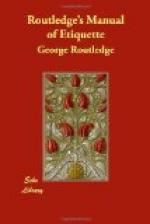The Deux Temps is a somewhat fatiguing valse, and after two or three turns round the room, the gentleman should pause to allow his partner to rest. He should be careful to select a lady whose height does not present too striking a contrast to his own; for it looks ridiculous to see a tall man dancing with a short woman, or vice versa. This observation applies to all round dances, but especially to the valse, in any of its forms.
* * * * *
XIX.—THE NEW VALSE.
This graceful variation of the valse movement has not long been introduced into England, and is not yet so universally popular as it promises to become. It was, however, much danced in London last year, and there is reason to believe that it will be the favourite dance this season. It is more elegant than the Valse a Deux Temps, and more spirited than the Cellarius. The tempo is slower than that of the ordinary valse. The step is extremely simple.
Gentleman takes his partner as for the Valse a Deux Temps. Fall on the left foot, and make two glissades with the right (1st bar). Repeat, reversing order of feet (2nd bar). Lady begins with her right foot as usual. The step is the same throughout. Figure en tournant.
The peculiarity of this Valse lies in its accent, which cannot be properly explained in words, but must be seen to be understood. We recommend our readers to lose no time in acquiring a correct knowledge of the New Valse. It is unquestionably the most easy and most graceful dance which has appeared of late years, and we are told on first-rate authority that it is destined to a long career of triumphs.
* * * * *
XX.—LE GALOP.
The Galop, as its name implies, is the quintessence of all the “fast” dances. At the time of the Polka mania it was very much in vogue, and was almost as great a favourite as the Deux Temps. Although its popularity has greatly declined of late, it generally occurs twice or thrice in the programme of every ball-room; and the music of the Galop is, like the dance itself, so gay and spirited, that we should regret to see it wholly laid aside. The step is similar to that of the Deux Temps Valse, but the time is 2/4, and as quick as possible. Two chassez steps are made in each bar. The figure can be varied by taking four or eight steps in the same direction, or by turning with every two steps, as in the Deux Temps. Like all round dances, it admits of an unlimited number of couples. Being, perhaps, the most easy of any, every one takes part in it, and the room is generally crowded during its continuance. A special amount of care is therefore necessary on the part of the gentleman to protect his partner from accidents.
We have now described all the round dances at present in vogue.
* * * * *




